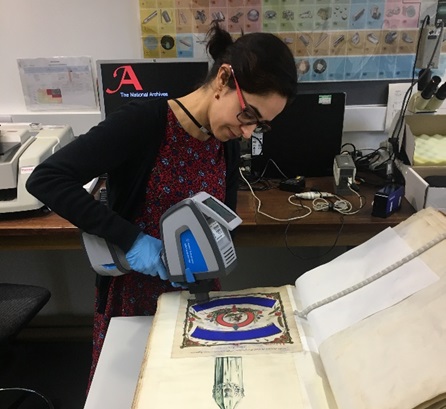This spring, several new research staff have joined our Collection Care Department. Our Collection Care research programme is designed to enable staff to predict the long-term stability of our holdings. They do this by increasing understanding of:
- the materials used to create records
- degradation processes
- mitigation of deterioration
- the relationship of materials to the environment in which they are stored
In the second of our two-part blog series we meet Lucia, the new senior conservation scientist and Natalie, research and development conservator. Lucia is undertaking dynamic long-term projects including research into wax seals and consolidants for paints, and Natalie is investigating the use of ATP (adenosine triphosphate) kits to detect historic mould and creating protocols for the department’s new multi-spectral imaging system (MSI). Both researchers are also contributing to the wider field of heritage science through dissemination activities and collaborations.
Lucia Pereira Pardo, Senior Conservation Scientist
What did you do before you joined The National Archives?
I worked as a conservation scientist at Historical Royal Palaces, where I was involved in the technical analysis of the Rubens ceiling paintings at the Banqueting House and the environmental monitoring and protection of the Tudor tapestry collection at Hampton Court Palace, among other projects.
For three years, I was also a postdoctoral research fellow at the Scientific Research department of the British Museum, where I explored the use of Er:YAG lasers in conservation, performed digital reconstructions of the original polychromy on medieval sculptures or investigated the production of Hokusai’s woodblock prints.

Lucia performing FTIR analysis
Before that, I was part of the MINIARE project at the University of Cambridge, performing non-invasive analysis of large groups of illuminated manuscripts from a wide range of periods and origins. Some examples can be seen here: https://www.fitzmuseum.cam.ac.uk/illuminated/.
With a background in chemistry, I specialised in conservation science at the Spanish Institute of Cultural Heritage (IPCE) in Madrid and completed my PhD at the University of Santiago de Compostela, with a research project about the conservation and analysis of 16th-century wall paintings in Northern Spain.
What are you researching here?
I am going to work on a project about the conservation and material characterisation of wax seals, run experiments to test new ultra-low viscosity cellulosic consolidants for matte paint and paper, and explore any new avenues for research around materiality and conservation of the collection at The National Archives. I will be applying scientific techniques such as multispectral imaging, X Ray fluorescence spectroscopy or FTIR (Fourier-transform infrared spectroscopy).
How will the research you’re conducting in the Collections Care Department help you in the future?
My experience at TNA will be very helpful to develop my skills as a researcher, both in terms of technical expertise applying scientific techniques for material characterisation and also in terms of creativity and thinking out of the box, to identify research opportunities in the conservation studio and start new collaborative projects. I will get to know the collection better, learn more about paper and parchment degradation and conservation, and understand (and hopefully help solve!) the main conservation challenges that we face.
Natalie Brown, Conservator Research and Development (maternity cover)
What did you do before you joined The National Archives?
Prior to starting my role here, I was working towards my PhD in Heritage Science at UCL Institute for Sustainable Heritage as part of the SEAHA Doctoral School. My past research has focused on paper degradation, analysis techniques, and modelling future degradation rates of paper. My PhD thesis explores the use of accessible near-infrared spectroscopy tools to survey the current material composition and future degradation of library collections. I have also trained as a practical paper conservator, and before my PhD I worked as an Institute for Conservation (ICON) intern at the National Library of Scotland, at the National Trust, and the National Theatre Archives.
What are you researching here?
I have two main research projects. The first is to optimise ATP bioluminescence assay testing kits so they can be used to detect historic mould found on collection items. Once I establish a method for detection, we hope that conservators will be able to introduce this technology into their regular practice. If this is successful it will be an accessible and evidence-based method used to detect mould which will lead to more targeted mould cleaning strategies.
My second research project involves the new MSI system that arrived at the end of March. Increasingly, MSI has become a vital tool for investigating cultural heritage objects; it can aid in pigment, varnish or dye identification, the detection of under-drawings, identifying past conservation treatments, identifying deterioration of the materials, and increasing the readability of damaged documents and documents with faded inks. I am creating protocols for its use and exploring how The National Archives staff can get the most out of this valuable investigation technique.
How will the research you’re conducting in the Collections Care Department help you in the future?
My experience at The National Archives is a fantastic opportunity to apply research and technical skills learnt in my studies to real world problem solving, and to gain experience working as a researcher in a heritage institution. I am also learning about new research methods that I can use in the future, and collaborating with Collections Care staff has enabled me to build my professional network and skill share.